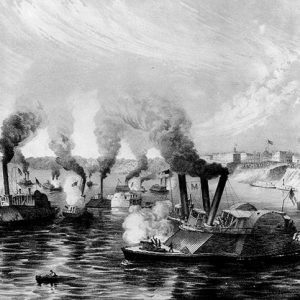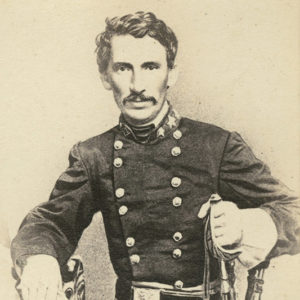calsfoundation@cals.org
CSS General M. Jeff Thompson
The CSS General M. Jeff Thompson was a Confederate ram that saw combat on the Mississippi River before being set afire and blown up during the 1862 Battle of Memphis.
The Confederate War Department purchased fourteen boats in 1862 with the intent of converting them into warships as the Mississippi River Defense Fleet under the command of Captain James E. Montgomery. One of them was named for M. Jeff Thompson, a brigadier general in the Missouri State Guard who would see extensive service in Arkansas.
Conversion of the steamboat, the original name of which is unknown, into the ram General M. Jeff Thompson began in New Orleans, Louisiana, on January 25, 1862, with the addition of a sheathing of four-inch-thick oak planks and inch-thick iron coating on her bow. In addition, compressed cotton bales were placed behind double pine bulkheads to provide extra protection. Thompson, who would lead troops of the Missouri State Guard as marines in the River Defense Fleet, described the vessel named after him as “the largest and best, but slowest Boat of the fleet.” Captain J. H. Burke was given command of the ram.
The Thompson’s conversion to a warship was finished by April 11, and the ram was sent up the Mississippi to help defend Memphis, Tennessee, from the Federal Mississippi Flotilla. The General M. Jeff Thompson was among seven Confederate vessels that confronted the Union fleet at Plum Point Bend near Fort Pillow in Tennessee on May 10, 1862, but was only able to fire its cannons at the Federal ships as other rams in the fleet sank a pair of gunboats.
The River Defense Fleet and General M. Jeff Thompson were back on the waters at Plum Point Bend, near Osceola (Mississippi County), in early June, holding off the Federal fleet as Confederate forces abandoned Fort Pillow, after which the fleet fell back to Memphis to refuel.
On June 6, 1862, Flag Officer Charles H. Davis led the U.S. Mississippi Flotilla to Memphis, where Confederate commander Montgomery, his boats still low on fuel, swung out to engage them. It was a disaster for the rebel fleet, as every one of its vessels was either destroyed or captured—only the General Earl Van Dorn escaped to the south because of its superior speed.
The General M. Jeff Thompson caught fire after being repeatedly struck by Union shells. Its crew ran it ashore and fled as the boat burned to the water’s edge. As the USS Carondolet steamed past the Thompson, it was reported that “she blew up with a tremendous report which sent all hands for their guns, as the bursting of the shells in her magazine sounded as if they had opened a battery on us.”
What was left of the CSS General M. Jeff Thompson remained at the head of President’s Island on the Mississippi after the war concluded. On January 18, 1867, the steamboat Platte Valley hit the submerged wreck, which “tore the bottom and sides out” of the Platte, causing “considerable” casualties, initially reported as sixty fatalities. The U.S. snag boat G. G. Totten blew up the wreck of the Thompson in July 1867, removing it as an impediment to river traffic.
For additional information:
“General M. Jeff Thompson.” Dictionary of American Fighting Ships. Online at www.hazegray.org/danfs/csn/g.txt (accessed May 25, 2022).
McCaul, Edward B., Jr. To Retain Command of the Mississippi: The Civil War Naval Campaign for Memphis. Knoxville: University of Tennessee Press, 2014.
“River Defense Fleet.” Dictionary of American Fighting Ships. Online at www.hazegray.org/danfs/csn/annex_2.txt (accessed May 25, 2022).
Stanton, Donal J., Goodwin F. Bearquist, and Paul C. Bowers, eds. The Civil War Reminiscences of General M. Jeff Thompson. Dayton, OH: Morningside, 1988.
Tomblin, Barbara Brooks. The Civil War on the Mississippi: Union Sailors, Gunboat Captains, and the Campaign to Control the River. Lexington: University Press of Kentucky, 2016.
Way, Frederick, Jr., comp. Way’s Packet Directory. Athens: University of Ohio Press, 1983.
Mark K. Christ
Central Arkansas Library System
 Civil War through Reconstruction, 1861 through 1874
Civil War through Reconstruction, 1861 through 1874 Military
Military Destruction of Rebel Fleet
Destruction of Rebel Fleet  M. Jeff Thompson
M. Jeff Thompson 




Comments
No comments on this entry yet.